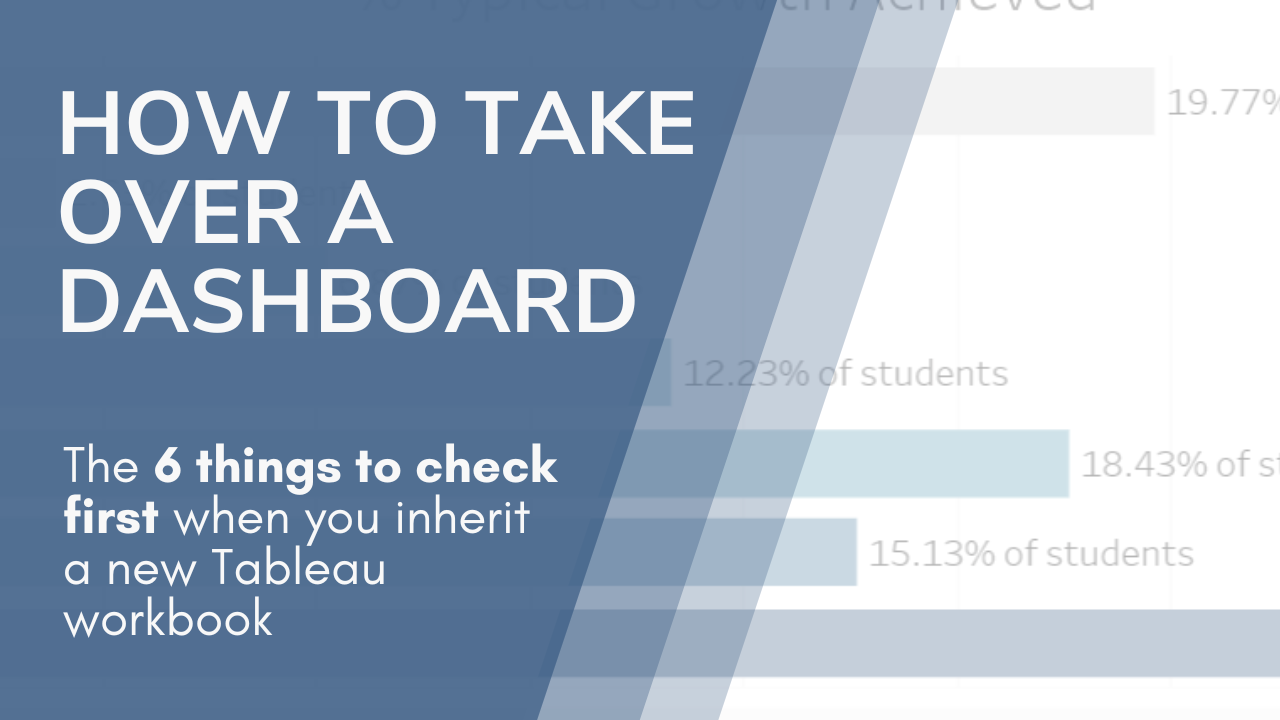When you work with Tableau professionally, one thing is inevitable: Sooner or later, you’re going to inherit a dashboard that someone else built. If you’re lucky, it’ll be a dashboard from a reliable team member who is still around to answer questions. If you’re less lucky, it’ll be from someone who left the company and can’t help you out. Hopefully there’s some documentation to help you out, but often there isn’t.
So where do you start? In this post, I’ll share the five steps I always take when inheriting a dashboard from another developer, plus some handoff tips for your own dashboards to prepare to pass them on one day.
1. Do a Sanity Check
First things first: Does this dashboard actually work? Start by clicking around the dashboard and making sure everything works as expected. Make sure that you understand what each visual is representing, and that the filters all do what you think they should.
Handoff tip: Maintain your dashboards! Check in on your old work occasionally to make sure it’s still functioning.
2. Confirm Data Source Access
If the dashboard uses a live or scheduled extract connection to update data automatically, you might need to change the old credentials to use yours instead. Go to the data source tab and open each source to make sure it connects. When you republish the dashboard, make sure “embed credentials in connection” is selected, and that your credentials load correctly.
Handoff tip: When possible, use team credentials instead of personal credentials to connect to external data sources. Make sure that multiple people can access the sources you use.
3. Look At Data Source Filters
Have you ever been tripped up by a sneaky data source filter? I have! Filters applied directly to the data source don’t show up on the normal filter pane, so they’re easy to miss. It’s critical to know what’s in between your data source and your dashboard, so make sure you check the filters on each data source and understand what they do.
Handoff tip: Give data source filters meaningful names, and make sure you mention them in your documentation.
4. Check Out the Dashboard Actions
Does the dashboard have any dashboard actions applied? Open the actions dialog, and make sure you understand what each action is doing. Remember that if you add new sheets to the dashboard, they may get auto-added to the actions. You may need to go back in and remove any new sheets from each action manually if they’re not relevant.
Handoff tip: Don’t use the default names for actions! Give your actions names that make it clear what they do, and (ideally) which sheets they should be applied to. Ex: “Filter Map from Bar Click” instead of “Filter Action (1)”.
5. Find Hidden Objects
Sometimes sheets on the dashboard won’t be immediately visible – maybe they’re controlled by dynamic zone visibility, or hidden behind floating objects. In the dashboard sheet pane, click through each sheet one-by-one and make sure you know where each one is used.
Handoff tip: Group dynamic zones into containers with descriptive names (Ex: “Time Series Sheet Swapper”).
6. Understand the Calculations
Go through each calculated field, look at the logic, and figure out what it does and how it’s used. Here’s a tip: If you want to see some of the places a calculated field is used, try to delete it. (Don’t actually delete it! Click “cancel” instead of delete when the dialog opens). When the “Are you sure?” dialog opens, you’ll see a partial list of the other fields and sheets the field appears in. To identify exactly which other fields rely on a calculated field, make a backup copy of the workbook and delete the calculated field. Fields that use it will get a red exclamation point next to them.
Handoff tip: Use a common prefix (like “c.fieldname”) or group your fields using folders (my preference) to clarify how sets of fields are used.
I hope you found these tips helpful! Next time you inherit a workbook, whether it’s from a rockstar teammate or a disgruntled former employee, use these six steps to get started on the right foot.

Leave a Reply